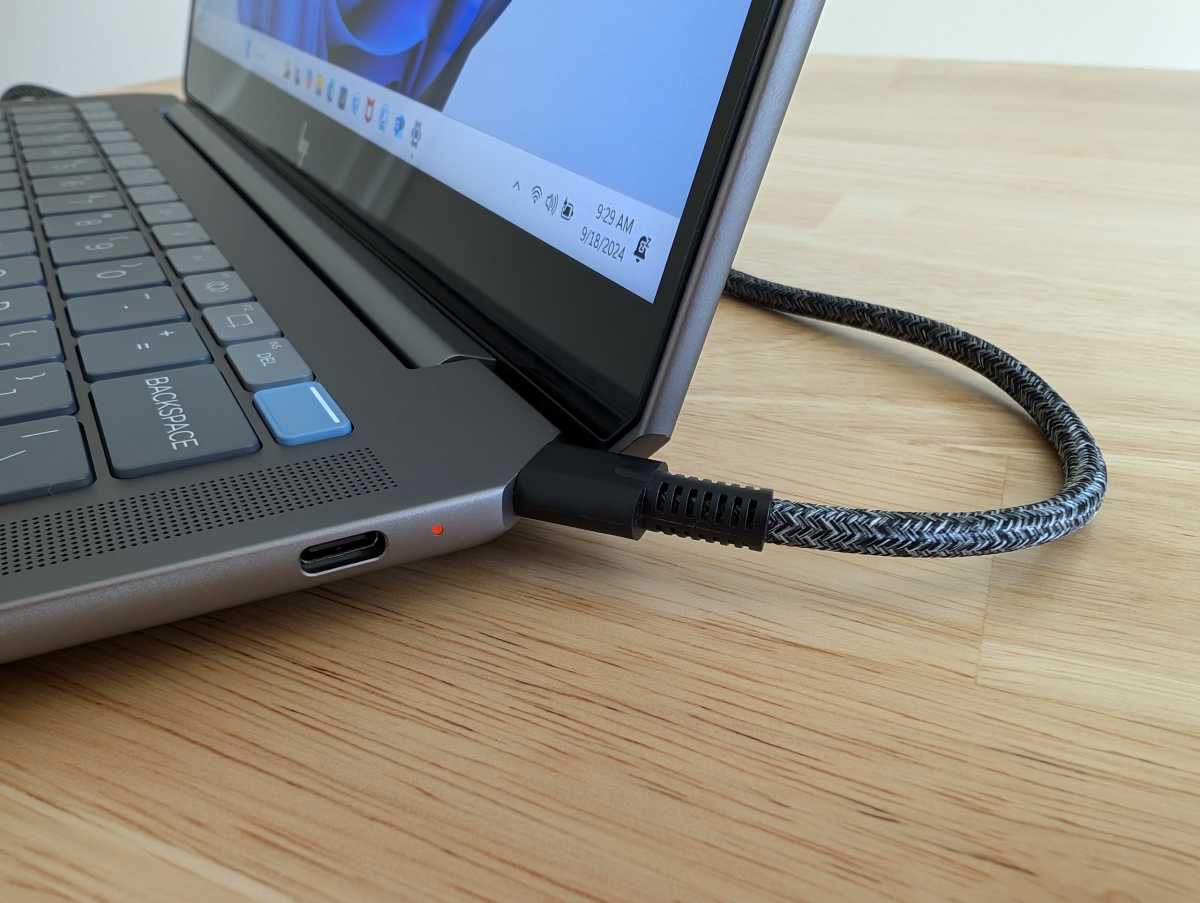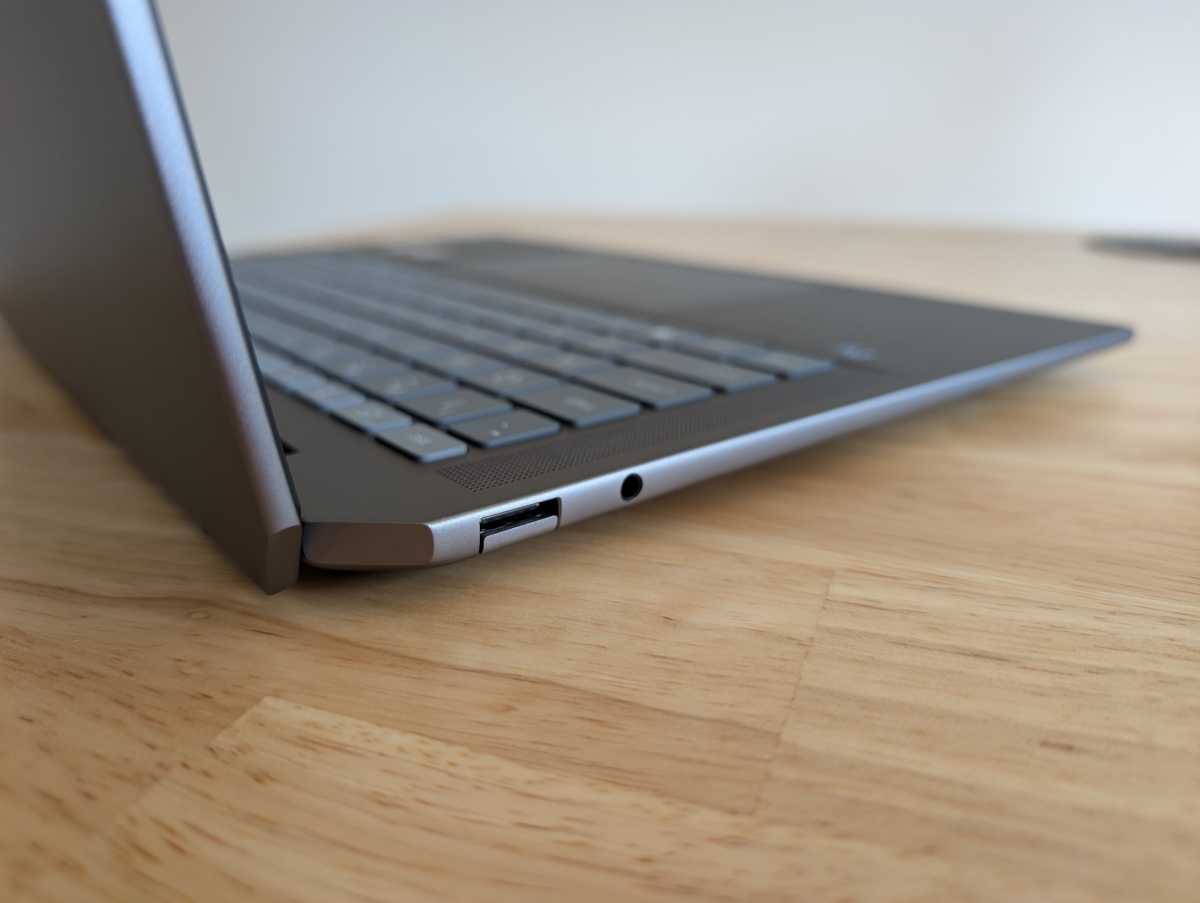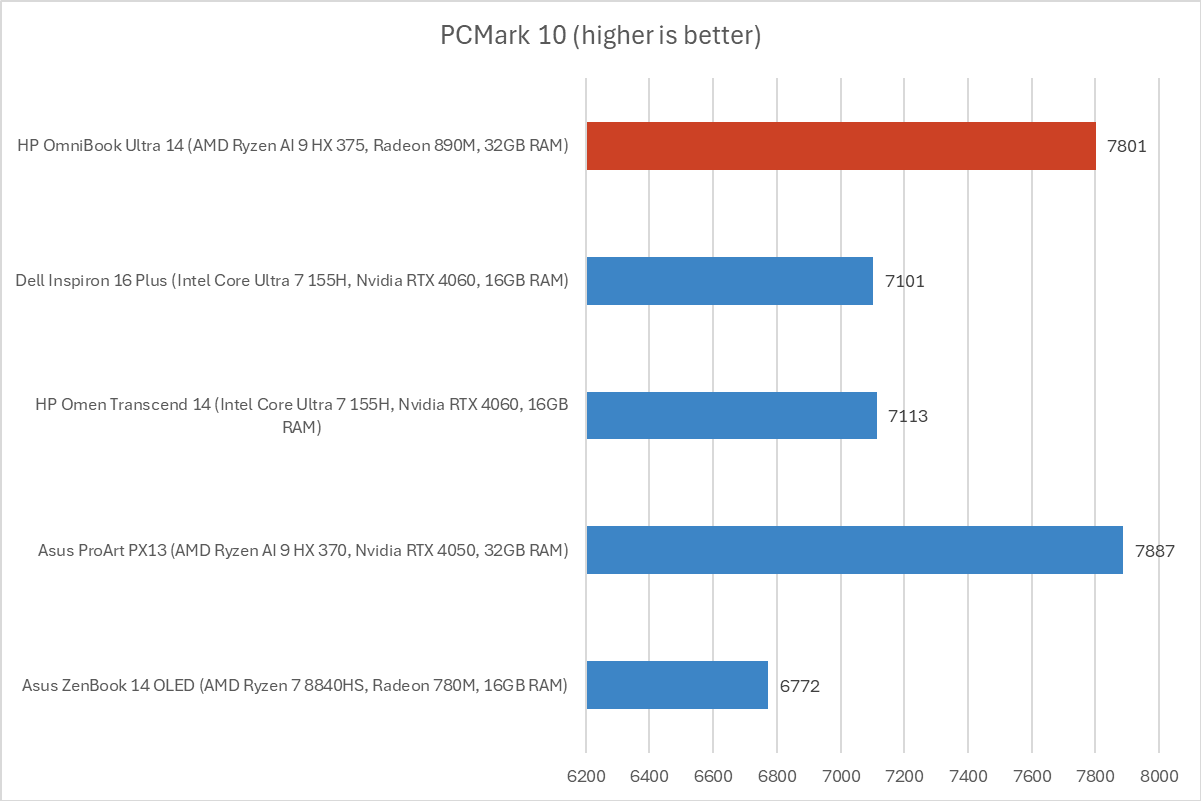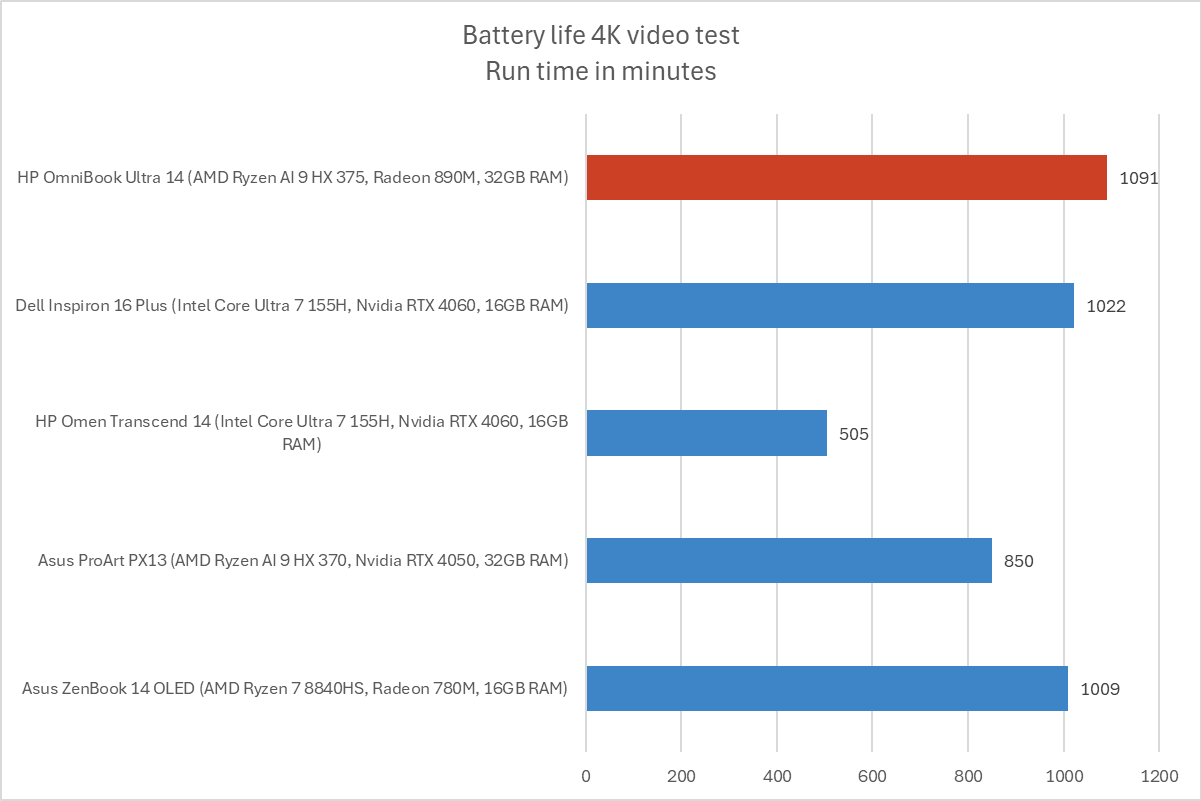Expert’s Rating
Pros
- Great real-world battery life
- Excellent performance thanks to Ryzen AI 300
- Solid build quality
Cons
- AI features are still questionable
- No Copilot+ PC AI features at lunch
- Port selection is minimal
- An OLED display would look nicer
Our Verdict
The HP OmniBook Ultra 14 shines thanks to AMD’s Ryzen AI 300 series processors, which delivers long battery life in real-world use with excellent performance. But “AI laptops” aren’t as futuristic as the marketing might lead you to expect.
Price When Reviewed
This value will show the geolocated pricing text for product undefined
Best Pricing Today
Best Prices Today: HP Omnibook Ultra 14
The HP OmniBook Ultra 14 is a “next-gen AI PC” thanks to its AMD Ryzen AI 300 series processor. But, while this machine has a neural processing unit (NPU) for local AI applications — plus Copilot+ PC features coming soon — AI isn’t the big story here. Look past the “AI” logos on this machine and you’ll find a solid laptop that gets long battery life and excellent performance in real-world use thanks to AMD’s latest hardware.
First, a word about the name: Back in May 2024, HP announced a rebranding of its entire PC lineup, dumping names like “Spectre” and “Dragonfly.” The word “OmniBook” here means this is a consumer laptop. If this was intended for commercial users, HP would call it an “EliteBook” or “ProBook.” (However, HP will still use “Omen” to refer to gaming PCs).
Further reading: Best laptops 2024: Premium, budget, gaming, 2-in-1s, and more
HP OmniBook Ultra 14: Specs
The HP OmniBook Ultra 14 comes with an AMD Ryzen AI 300 series processor. This hardware includes a neural processing unit (NPU) with up to 55 TOPS for local AI applications. That’s why HP is positioning this as a “next-gen AI PC” — it will soon be compatible with Copilot+ PC features, unlike previous-generation “AI PCs” with hardware like Intel’s Meteor Lake.
There are several variations of this PC. HP loaned us a “top of the line” model with an AMD Ryzen AI 9 HX 375 CPU, 32 GB of RAM, and 2 TB of solid-state storage. This package is available at Best Buy for a retail price of $1,689.99.
A few other variations are also available, with the least expensive one being a AMD Ryzen AI 9 365 processor, 16 GB of RAM, and a 512 GB SSD. This is available through HP’s online store for $1,349.99.
- Model number: HP OmniBook Ultra 14-fd0023dx
- CPU: AMD Ryzen AI 9 HX 375
- Memory: 32 GB LPDDR5 RAM
- Graphics/GPU: AMD Radeon 890M
- Display: 14-inch 2240×1400 IPS display with 60Hz refresh rate and touch screen
- Storage: 2 TB PCIe Gen 4 solid-state drive
- Webcam: 9MP 1440p webcam with physical privacy shutter
- Connectivity: 2x USB Type-C (Thunderbolt 4, USB4 40Gbps), 1x USB Type-A (10Gbps), 1x combo audio jack
- Networking: Wi-Fi 7, Bluetooth 5.4
- Biometrics: IR camera and fingerprint reader
- Battery capacity: 68 Watt-hours
- Dimensions: 12.41 x 8.96 x 0.65 inches
- Weight: 3.47 pounds
- MSRP: $1,689 as tested
The HP OmniBook Ultra 14 is a great computer. It’s sturdy and well put together — and, most importantly, it has an AMD Ryzen AI 300 series processor. These just have better performance and longer battery life than Intel’s Meteor Lake chips.
HP OmniBook Ultra 14: Design and build quality

IDG / Chris Hoffman
The HP OmniBook Ultra 14 is a well-designed, solid piece of mostly silver metal on the parts of the laptop you’ll touch. (There are just a few plastic elements, like the bezel.) While HP has changed the branding of its consumer laptops, there’s a lot of the “Spectre” design language here. The angular corners where the display meets the bottom tray of the laptop are immediately and recognizably HP.
The 14-inch OmniBook Ultra 14 feels like a solid machine. At 3.47 pounds, it’s a tad heavier than some “thin-and-light” laptops, but it has a good weight distribution and it’s a very reasonable size and weight. The hinge is sturdy.
The charger HP bundles is unusually nice, too — it has a nice braided cable. As many of us have noticed with phones, braided USB charging cables tend to hold up better over the long run.
While HP is pushing the “AI PC” angle here — complete with an “AI” logo below the left side of the keyboard and on the back of the hinge — bear in mind that this machine won’t get Copilot+ PC features until Microsoft rolls them out in November 2024. However, those Copilot+ PC features aren’t too interesting yet anyway.
HP does bundle an “HP AI Companion” app with this machine. This app integrates a variety of AI tools that use the system’s NPU to analyze data in files, for example, and to guide you through changing various PC settings. It’s good to see PC manufacturers include tools that demonstrate the power of the AI hardware they’re pushing, but this isn’t life-changing software that will make you want to seek out an AI laptop.
There’s a bit of bloatware installed here. The noisiest one is McAfee antivirus, which nags you to set it up, but you can easily uninstall McAfee. There’s also a Dropbox promotion, as well as Adobe offers and Google essentials apps in the Start menu. It’s not the cleanest setup out of the box, but it’s easy to uninstall what you don’t want.
HP OmniBook Ultra 14: Keyboard and trackpad

IDG / Chris Hoffman
The HP OmniBook Ultra 14 has a full-size keyboard with a backlight you can toggle off and on. It’s placed nicely at the center of the laptop, and the keys feel great to type on. I don’t consider them mushy at all. I was able to type accurately at high speeds.
And naturally, since this is an AI laptop, it has a Copilot key to the right of the right Alt key on the keyboard.
This machine has well-size trackpad sitting centered right below the keyboard, too. It’s a good size for the laptop — not too small and not too large. Palm rejection worked excellently well typing. The surface felt smooth and responsive, whether I was moving the cursor with a finger, scrolling with two fingers, or using multi-touch gestures.
The trackpad’s click action also felt pleasantly responsive, although I’ve been spoiled by haptic touchpads like those on the Surface Laptop 7 and would like to see more laptops use them.
HP OmniBook Ultra 14: Display and speakers
The HP OmniBook Ultra 14 includes a 14-inch IPS display with 2.2K resolution — that’s 2240×1400 pixels. This is a 60 Hz display with up to 400 nits of brightness, and it’s also a touchscreen. The screen looks good, although it could offer more brightness. For a productivity-focused laptop like this one, it works well. For productivity and general web-browsing and media consumption, I was perfectly happy with it.
Still, the limitations are obvious, even on paper: 400 nits on the low side for brightness, and some people may want more. A refresh rate faster than 60Hz is always nicer, too. OLED screens are much more beautiful, but they’re also expensive and tend to use more power, decreasing battery life. The screen is also a little glossy, and an antireflective coating, higher brightness, or a matte finish may be preferrable. That’s up to you and how you plan to use your laptop.
This laptop’s quad-speaker setup is one of the better speaker configurations I’ve heard on a 14-inch productivity laptop. It has a good amount of volume, a fairly wide soundstage, and more bass than the average 14-inch laptop — which, I’m aware, isn’t saying much! Laptop speakers will always be fighting an uphill battle, but these are solid speakers. These aren’t the cheap tinny speakers you’ll unfortunately see on many low-priced laptops
HP OmniBook Ultra 14: Webcam, microphone, biometrics
The HP OmniBook Ultra 14 has a nicer webcam than most laptops — at least on paper. It features a 9 megapixel 1440p webcam — most laptops I review tend to have 1080p webcams at most. The picture looks clear in a variety of lighting conditions, although I would’ve expected it to look a tad sharper. You also have access to a variety of AI effects for tweaking your webcam video through Windows Studio Effects as well as HP’s bundled software.
There’s also a physical shutter switch above the webcam, which you can slide to block the webcam. That’s always a great feature to have.
The OmniBook Ultra 14’s built-in microphone did a good job of picking up my voice, although I feel like I’ve heard clearer audio from some other laptops. Between the webcam and microphone, this is a perfectly fine laptop for online meetings, although I imagine the ProBook and EliteBook laptops HP is targeting at professional users might have upgraded webcams and microphones.
This laptop features both an IR camera for facial recognition and a fingerprint sensor. The fingerprint sensor is integrated into the blue power button at the top-right corner of the keyboard. You can use either or both with Windows Hello. Both facial recognition and fingerprint recognition worked well, quickly letting me sign into the laptop.
HP OmniBook Ultra 14: Connectivity

IDG / Josh Hendrickson
The HP OmniBook Ultra 14’s port selections are limited. On the right side, you’ve got two USB Type-C (Thunderbolt 4 / USB4 40Gbps) ports — one of which is on the angled edge. It works very nicely with the laptop’s own power cable.
HP was proud to inform me that this is the first AMD-powered consumer laptop the company has released with Thunderbolt 4 ports. Bear in mind that you will use one of these ports to charge the laptop, leaving one port free while the laptop is charging.
On the left side of the laptop, you’ve got a USB Type-A port (10Gbps) and a combo audio jack. This isn’t a terrible selection of ports — some modern laptops are ditching USB Type-A ports or even the audio jacks. But, if it’s important for you to have more USB Type-C ports, more USB Type-A ports, or features like a microSD reader or HDMI out port, you’ll need to look elsewhere or get a dongle.
Since this machine is using AMD’s Ryzen AI 300 series hardware, it offers both Wi-Fi 7 and Bluetooth 5.4 wireless connectivity. It’s a great futureproof hardware setup.
HP OmniBook Ultra 14: Performance
The HP OmniBook Ultra 14 delivered excellent performance in desktop productivity apps thanks to its modern AMD Ryzen AI 9 HX 375 processor combined with 32GB of RAM and a 2TB solid-state drive. AMD’s new hardware is no slouch.
As always, we ran the HP OmniBook Ultra 14 through our standard benchmarks to see how it performs in more detail.

IDG / Chris Hoffman
First, we run PCMark 10 to get an idea of overall system performance. This benchmark is designed to measure overall system performance, but it’s particularly focused on CPU performance.
The HP OmniBook Ultra 14 posted an overall PCMark 10 score of 7,801. That’s a tad behind the more expensive, creator-focused Asus ProArt PX13, which has a similar Ryzen AI 300 series CPU. But it’s nicely ahead of Intel Meteor Lake-powered laptops.

IDG / Chris Hoffman
Next, we run Cinebench R20. This is a heavily multithreaded benchmark that focuses on overall CPU performance. It’s a quick benchmark, so cooling under extended workloads isn’t a factor. But, since it’s heavily multithreaded, CPUs with more cores have a huge advantage.
With a multi-threaded score of 7,582 in Cinebench R20, the HP OmniBook Ultra 14 performed well. It’s somewhat behind the Asus ProArt PX13. But, once again, it’s nicely ahead of Intel Meteor Lake laptops.

IDG / Chris Hoffman
We also run an encode with Handbrake. This is another heavily multithreaded benchmark, but it runs over an extended period. This demands the laptop’s cooling kick in, and many laptops will throttle and slow down under load.
The HP OmniBook Ultra 14 took 896 seconds — that’s just under fifteen minutes — to complete the encode process. That’s a big longer than the Asus ProArt PX13, but once again beats those Intel Meteor Lake-powered laptops.

IDG / Chris Hoffman
Next, we run a graphical benchmark. This isn’t a gaming laptop, but it’s still good to check how the GPU performs. We run 3Dmark Time Spy, a graphical benchmark that focuses on GPU performance.
The HP OmniBook Ultra 14 and its Radon 890M graphics delivered a score of 3909 in 3DMark Time Spy. Most of the other laptops we’re comparing this machine to have discrete Nvidia graphics, so you can see how critical discrete graphics are. But the Radeon 890M graphics are a nice step up over the older Radeon graphics in the older Asus ZenBook 14 OLED system we’re comparing it to here.
Overall, the HP OmniBook Ultra 14 delivered excellent performance. It’s not quite as fast as the Asus ProArt PX13 in our benchmarks, but it handily beats similar systems powered by Intel Meteor Lake processors. Of course, this system doesn’t have discrete graphics, so it’s not ideal for gamers and people who need more 3D horsepower for professional applications.
HP OmniBook Ultra 14: Battery life
The HP OmniBook Ultra 14 includes a 68 Watt-hour battery. This has AMD’s new Ryzen AI 300 series hardware. While our benchmarks show it may not be as long-lasting as Intel Lunar Lake or Qualcomm Snapdragon X Elite hardware, it is AMD’s latest hardware that delivers more power efficiency than most of the laptops you’ll find on the shelves.

IDG / Chris Hoffman
To benchmark the battery life, we play a 4K copy of Tears of Steel on repeat on Windows 11 with airplane mode enabled until the laptop suspends itself. We set the screen to 250 nits of brightness for our battery benchmarks. This is a best-case scenario for any laptop since local video playback is so efficient, and real battery life in day-to-day use is always going to be less than this.
The HP OmniBook Ultra 14 lasted 1,091 minutes, which is just over 18 hours. That’s a great result — and it beats the Asus ProArt PX13 along with those Intel Meteor Lake-powered systems. But lots of laptops post high numbers in this benchmark only to drain faster in day-to-day use.
Synthetic benchmarks aside, I’ve found that Ryzen AI 300 series laptops — both this machine and the Asus ProArt PX13 I reviewed — deliver long battery life in typical desktop usage with the productivity apps I use. (For me, that means applications like Google Chrome, Microsoft Word, Slack, OneNote, Excel, and other desktop applications). This machine lands in the ballpark of all-workday battery life for my usage — though, again, it really depends on the applications you’re using, the screen brightness you choose, and so on.
HP OmniBook Ultra 14: Conclusion
The HP OmniBook Ultra 14 is a great computer. It’s sturdy and well put together — and, most importantly, it has an AMD Ryzen AI 300 series processor. These just have better performance and longer battery life than Intel’s Meteor Lake chips. Plus, unlike with a Qualcomm Snapdragon X Elite-powered laptop, you don’t have to worry about compatibility concerns.
Because of that, I’d happily take this over an Intel Meteor Lake-powered laptop. The base model starts at $1349, which is a reasonable price for this new hardware — and it could be quite a good price if you find it on sale.
Still, it’s not for everyone. Some people will want a more beautiful OLED display, for example. Or you may be looking for discrete graphics so you can game or use professional tools that require that hardware. Or, perhaps you simply need more ports and aren’t looking forward to the dongle life.
The big question is Intel’s Lunar Lake. When Lunar Lake laptops have taken Meteor Lake’s place in the market, you may have many more options for this kind of performance and energy efficiency.
Still, this is a great laptop at a fair price — if this hardware is what you’re looking for.




